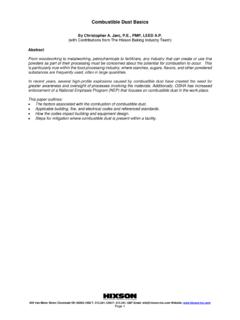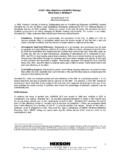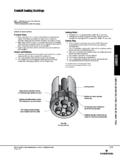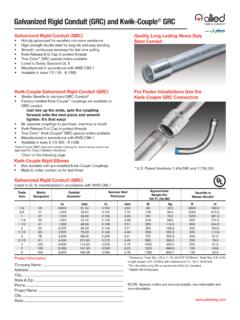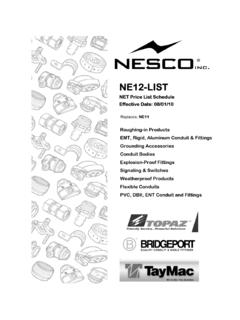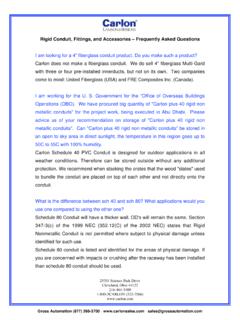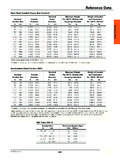Transcription of Prevention of Condensation on Conduits that …
1 Prevention of Condensation on Conduits that penetrate insulated metal Panel 659 Van Meter Street Cincinnati OH 45202-1568 T: 513 241 1230 F: 513 241 1287 Email: Website: Scott T. McGlamery, ; Bret T. Heckman, Department of Electrical Engineering, Hixson, Cincinnati, OH Abstract - Condensation is a concern in every food plant, because it can provide a breeding ground and serve as a vehicle for microbes. A particularly challenging application for Condensation control are penetrations of insulated metal panels between warm and cold spaces. Hixson has conducted research to determine the most effective way to control Condensation on Conduits in this situation. I. Introduction conduit penetrations through walls or ceilings of a food production facility are inevitable.
2 When a conduit spans two rooms with a significant temperature difference, Condensation can form on the inside and outside of a conduit . This unwanted water could provide a niche for microbial harborage. Condensation is usually a concern in any room conditioned below 40 F. For example, there is a walkable ceiling directly above a food processing room. The food processing room will be cooled to approximately 38 F, while the walkable ceiling could be exposed to ambient conditions. On a warm summer day, the walkable ceiling could reach temperatures above 80 F with high humidity. The only separation between these spaces would be a 4 insulated metal panel. A conduit between these spaces would be warm on one side and cold on the other. (See Figure 1.) Condensation occurs when the surface temperature of an object is below the dew point of the surrounding atmosphere.
3 If the conduit spanning both spaces is not properly addressed, the temperature on the warm side can be less than the dew point. Much like a cold beverage sitting outside on a summer day, water will bead up on the surface and drip down the inside and outside of the conduit . Collection of this water can create a breeding ground for microbes. Hixson has made observations in the field regarding the Condensation build up in and on Conduits that run from a conditioned space to an unconditioned space. These situations happen most commonly when there is a temperature difference between spaces of at least 30 F. Figure 1: Heat transfer on a conduit through an insulated metal panel. Design, selection, and installation of conduit penetrations can help significantly reduce or eliminate the amount of Condensation that occurs in a facility.
4 II. Test Setup and Procedure An apparatus was constructed to simulate a cold environment separated from a hot environment. To segregate the spaces, 4 insulated metal panel was used and different conduit types were used to span the areas. To create the cold environment, a plastic bin was filled with a water/ice bath mixture. When covered with the 4 insulated metal panel, it created a space temperature around 35 F. Testing was conducted in an open area in August with temperatures ranging from 86 F to 93 F. Two pieces of insulated metal panel were penetrated with five Conduits . The penetration was then sealed with silicone caulk. Conduits used for the experiment were 10 long and each made of a different material. These materials were stainless steel, Schedule 80 PVC, rigid steel, aluminum, and PVC coated rigid steel.
5 Prevention of Condensation on Conduits that penetrate insulated metal Panel 659 Van Meter Street Cincinnati OH 45202-1568 T: 513 241 1230 F: 513 241 1287 Email: Website: Thermistors were then installed at incremental locations on each conduit . Below the insulated panel the thermistors were located at 8 below the bottom of the panel. Thermistors were also located above the panel up to 40 . Figure 2: Conduits from left to right SST, Schedule 80 PVC, aluminum, rigid steel, and PVC coated rigid steel Once the thermistors were installed, closed cell rubber foam pipe insulation was fitted around each conduit . Several tests were conducted using thick insulation and thick insulation at lengths of 12 , 24 and 36 and with no insulation. The goal was to test each conduit under the same conditions to measure the heat transfer through the conduit by the use of thermistors and observations.
6 Figure 3: 3/4 Insulation installed 36 above the insulated metal panel. III. Analysis The resistances of the thermistors were measured, documented and converted to temperature. For the experiment involving 36 of insulation, 29 thermistors were used over a 48 span of the conduit . Five of the thermistors were located below the insulated metal panel and the remaining 24 were located above. When readings were taken when no insulation was present, the thermal conductive properties of each material type became apparent. For clarity of results, the heat transfer of two uninsulated Conduits can be found in Graph 1. Prevention of Condensation on Conduits that penetrate insulated metal Panel 659 Van Meter Street Cincinnati OH 45202-1568 T: 513 241 1230 F: 513 241 1287 Email: Website: Graph 1: Heat Transfer on SST and Aluminum Conduits .
7 Distance zero represents the top of the insulated metal panel. The ambient temperature below the insulated metal panel inside the bucket is approximately 35 F. The ambient temperature above the insulated metal panel is approx. 93 F. Aluminum is ~15 F lower than stainless steel as it exits the insulated metal panel. Because the aluminum conduit has a lower temperature, it is more likely to be closer to the dew point of the space. This condition frequently leads to Condensation on a conduit . (Graph 1 shows that aluminum is greatly impacted by the environment it is in and proves that the higher the thermal conductivity, the more influenced a conduit will be by the temperature of the environment.) See Table 1 for examples of materials and their thermal conductivity. Graph 2 represents temperature readings for each the different insulation configurations.
8 The temperature points shown are from the thermistor located at point 0 or the top of the insulated metal panel. Graph 3 indicates that temperatures of Conduits gradually rise as they reach the end of the insulation. Material Thermal Conductivity(W/m*K) Polystyrene ( metal panel insulation) Schedule 80 PVC SST PVC Coated Steel N/A Steel 50 Aluminum 247 Copper 398 Table 1: Thermal Conductivity of Materials Prevention of Condensation on Conduits that penetrate insulated metal Panel 659 Van Meter Street Cincinnati OH 45202-1568 T: 513 241 1230 F: 513 241 1287 Email: Website: Graph 2: Temperature readings immediately above the insulated metal panel penetration.
9 The length of the insulation is shown as 12 , 24 or 36 and the thickness is 1/2", or 3/4". For no insulation, readings were taken as the Conduits penetrated the insulated metal panel. Graph 3: Temperature readings immediately above the insulation. For no insulation, readings were taken as the Conduits penetrated the insulated metal panel. Prevention of Condensation on Conduits that penetrate insulated metal Panel 659 Van Meter Street Cincinnati OH 45202-1568 T: 513 241 1230 F: 513 241 1287 Email: Website: Graph 4: Temperature readings above the insulation for all 5 Conduits with 36 long 3/4" thick and 12 long 1/2" thick insulation. For no insulation, readings were taken as the Conduits penetrated the insulated metal panel. When reviewing the extremes of insulation coverage, a noticeable difference emerges. The temperature of the Conduits covered with 36 of 3/4" insulation keeps the temperature of the Conduits lower as they penetrate the insulated metal panel and reach the end of the insulation, whereas the 12 of 1/2" insulation allows the temperature of the Conduits to rise closer to ambient conditions above the panel.
10 Graph 4 proves that insulating the conduit too well will actually increase the chances of Condensation forming. By using shorter, thinner insulation the heat from the warm side of the space is able to travel farther down the conduit . This allows the conduit to become warmer in a shorter distance. In the cases where there was insulation, no Condensation was observed on any of the Conduits above the insulation. During the no insulation test, Condensation was observed on the aluminum conduit as it penetrated the insulated metal panel. IV. Conclusions Select materials with the lowest thermal conductivity possible that still meet corporate/facility standards for the environment they are located. Conduits with the lowest thermal conductivity provided a warmer conduit once it passed through the insulated metal panel from the cold side to the hot side.

